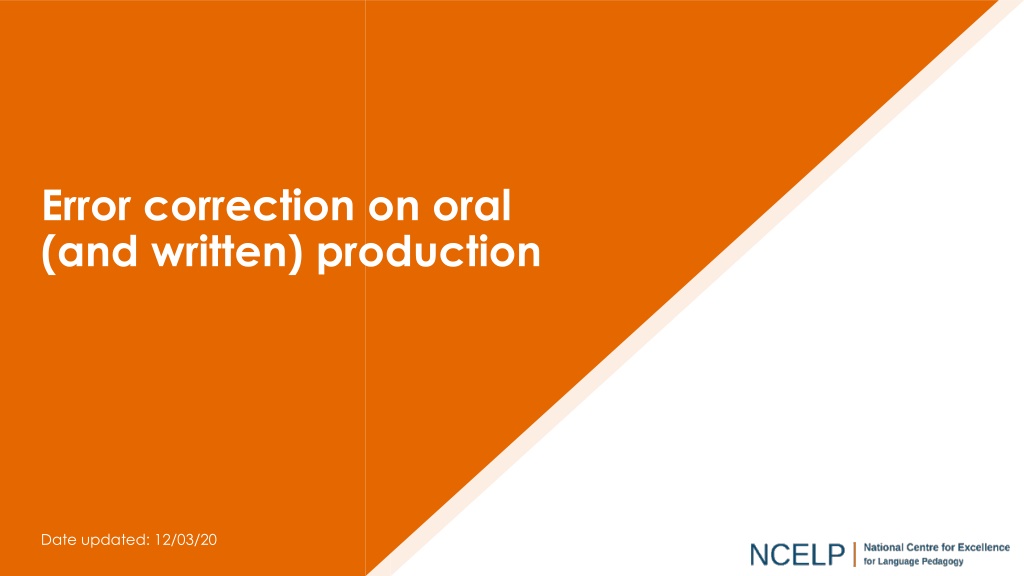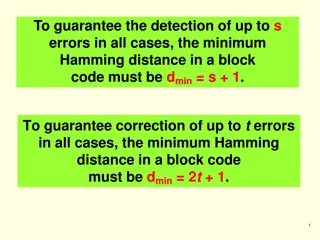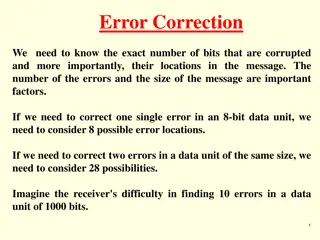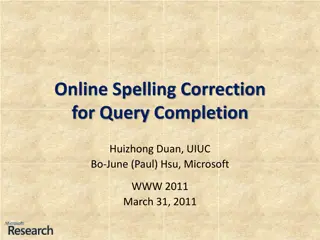Enhancing Language Learning Through Error Correction Strategies
Explore the importance of error correction in language learning based on recommendations from The Pedagogy Review. Discuss strategies to anticipate, correct, and provide feedback on errors in both spoken and written language to facilitate effective language acquisition and communication. Consider the impact of different correction approaches on student progress and engagement.
Download Presentation

Please find below an Image/Link to download the presentation.
The content on the website is provided AS IS for your information and personal use only. It may not be sold, licensed, or shared on other websites without obtaining consent from the author. Download presentation by click this link. If you encounter any issues during the download, it is possible that the publisher has removed the file from their server.
E N D
Presentation Transcript
Error correction on oral (and written) production Date updated: 12/03/20
Outline of the session 1. Understanding relevant extracts from The Pedagogy Review and considering opportunities for your own context (20 mins) 2. Brief history: how errors & error correction moved from the naughty corner to being A Good Thing (20 mins) 3. Raising awareness about the main types of corrections: The Recast, The Elicitation, and Metalinguistic Information (35 mins) 4. Evidence about effective correction (25 mins)
Part 1 Recommendations from the MFL Pedagogy Review about errors & error correction Read the four recommendations from the MFL Pedagogy Review, provided on the next four slides. Then, you will be invited to discuss: 1) the extent to which these are currently reflected in your own practice 2) the extent to which these are currently reflected in practice and policy in your own department and school 3) implications for change, at a) personal, b) departmental, c) school levels
Part 1.1 From the Pedagogy Review: Errors happen Errors: anticipation and correction 10.1 All of us make mistakes when learning a new language. Some of these can be anticipated by the teacher as new material is introduced, based on their knowledge of points of difficulty. Others can be the result of pupils attempting to put into words thoughts that are, as yet, beyond their knowledge of grammar or vocabulary. Teachers need to develop a range of strategies for dealing with these and other types of error, with the aim of providing pupils with clear and effective guidance, without discouraging them from tackling difficulties or, where necessary, taking risks.
Part 1.2 From the Pedagogy Review: When to correct 10.2 Error correction in both spoken and written language is most powerful when it can be done immediately. Lengthy written feedback or complex retrospective written corrections often have less impact. However marking pupils books, done in such a way as to make good use of teachers time to give focussed and manageable feedback, is an important part of teaching and assessment. Most helpfully, teachers understand from their review of pupils work what needs to be taught or practised further in lessons.
Part 1.3 From the Pedagogy Review: How to correct 10.3 While error correction is important for progress, consistently focussing on all errors in all contexts may become a distraction and actually limit practice because pupils become reluctant to try to communicate. Preparedness to try is a pre-requisite for necessary practice leading to use of new language. 10.4 Common strategies for error correction include: recasting re-stating what the pupil has said, accurately, but in a reflective and affirmative way; prompting - in which pupils are encouraged to reflect and correct the error for themselves; and, explanation where explicit, often metalinguistic, information is given about a rule relating to the cause of the error and how to avoid it in future.
Part 1.4 From the Pedagogy Review: What to correct 10.5 We know that some features of a language are particularly difficult to master recognising these is an important part of teachers pedagogical knowledge and should be continuously developed by language teams. These kinds of errors are to be expected and teachers should know that it can take time to reach accuracy in these areas, especially in oral production. Examples include: reliably accurate gender across all parts of speech (articles, adjectives); rich agreement systems, especially to express concepts that are not easily mapped to English (e.g., past habitual on all verb types); when to use and not to use subjects in Spanish; word order in German or Spanish to alter focus or emphasis.
Part 1 Recommendations from the MFL Pedagogy Review about errors & error correction Discuss: 1) the extent to which these are currently reflected in your own practice 2) the extent to which these are currently reflected in practice and policy in your own department and school 3) implications for change, at a) personal, b) departmental, c) school levels
Outline of the session 1. Understanding relevant extracts from The Pedagogy Review and considering opportunities for your own context (20 mins) 2. Brief history: how errors & error correction moved from the naughty corner to being A Good Thing (20 mins) 3. Raising awareness about the main types of corrections: The Recast, The Elicitation and Metalinguistic Information (35 mins) 4. Evidence about effective correction (25 mins)
Part 2.1 Brief history: Why we are where we are, and not in the land of grammar translation and rote repetition to get 100% accuracy (1) 1) Interaction Hypothesis (Long, 1985): Interactional modification makes input comprehensible -> Comprehensible input promotes acquisition -> interactional modification promotes acquisition
Part 2.1 Brief history: Why we are where we are, and not in land of grammar translation/rote repetition (2) 2/ Output hypothesis (e.g. Swain, 1995) Producing output helps because learners: A) notice what they can t say and then search how to do it B) engage in hypothesis testing (I ll try to say it like this and see if he understands) C) reflect metalinguistically Roles A & C have been researched a lot But oh no! Producing genuine meaning leads to errors!! What do we do about that?! The interaction & output hypotheses seeped into the psyches of researchers, teacher educators, advisors, publishers, testers, teachers So, we know learning happens when learners try to produce real meaning, by speaking and writing moves away from rote, mechanical repetition and away from a pure focus on perfectly accurate translation
Part 2.2 Brief history: What do we do about errors? We give corrective feedback Feedback can be: On written production On spoken production Positive: that s correct ; evidence of successful communication Negative: an error correction; impaired communication Implicit: frown; rephrase (recast) Explicit: say correct ; say no ; explain error Experienced-to-novice (e.g., teacher -> student; native speaker -> learner) Peer to peer (e.g., student to student)
Part 2.3 Brief history: But, why should we correct? Children don t need correcting in their first language Caregivers don t really correct language (they correct content!) and, anyway, it doesn t really work
Part 2.3 Brief history: Does explicit correction work when learning our first language? Child: Want other one spoon, Daddy Father: You mean, you want the other spoon Child: Yes I want other one spoon, please Daddy Father: Can you say the other spoon Child: Other one spoon Father: Say other Child: Other Father: Spoon Child: Spoon Father: Other spoon Child: Other spoon . Now give me other one spoon! (From Cazden 1972 in Aitchison 1998: 70)
Part 2.4 Brief history: A big debate in the history of language teaching: Negative evidence versus positive evidence Two types of input (=data from which to pick out the language system): positive evidence and negative evidence. Positive evidence tells the learner of what is acceptable in the language. It contains the set of well-formed sentences to which learners are exposed (Gass, 1997; p. 36). Negative evidence provides information about incorrectness. It can be through correcting non-target-like production. Are both types of evidence necessary? Or is only positive evidence sufficient? at the heart of debates about purely communicative versus more language-focused approaches to teaching
Part 2.4 Brief history: Argument 1: Learners need only positive evidence! Give them lots of language over and over Some might say: don t correct much or don t correct at all very heavily meaning-focused approaches: immersion, CLIL (more implicit approaches) correction demotivates correction isn t useful for learning (Krashen, 1981; Schwartz, 1993, Truscott, 2007)
Part 2.4 Argument 2: Negative evidence is necessary because How do you say do you like do you eat? go ? How do you say doesn t like he doesn t You can notice that a sound, a word or grammar DOES exist you hear it, you see it! But how do you know if something can tbe said ? If something exists in your first language, you need to be toldif doesn t exist in another. For example, Do in English questions Students are taught French questions: use intonation; swap round S-V; use est-ce que Then, a bright 16 year-old floors you: They know how French does work, from positive evidence from teachers & books but they can t just work out how it does NOT work, without being told.
Part 2.4 Argument 2: Negative evidence is useful because In last three decades, evidence for strong role for negative evidence: external scaffolded attention internally motivated attention explicit knowledge explicit memory implicit learning implicit memory, automatization and abstraction. N C Ellis (2005) Feedback promotes skill acquisition: knowledge changes from: declarative -> proceduralised -> automatised Corrective feedback is one way of making declarative knowledge available in a useable form [immediate, memorable, salient] R Ellis (2007, p. 358)
Part 2.5 Summary: A brief history of how error correction moved from the naughty corner to being A Good Thing Getting it wrong and getting corrected negative evidence! This seems particularly helpful when the L2 appears to be a bit like the L1 but isn t really! Can you think of language features that are cross- linguistically similarbut are, in fact, different?!
Outline of the session 1. Understanding relevant extracts from The Pedagogy Review and considering opportunities for your own context (20 mins) 2. Brief history: how errors & error correction moved from the naughty corner to being A Good Thing (20 mins) 3. Raising awareness about the main types of corrections: The Recast, The Elicitation and Metalinguistic Information (35 mins) 4. Evidence about effective correction (25 mins)
Part 3 Part 3: Increasing awareness about how we correct spoken production From almost invisible to in your face
Part 3 Increasing awareness about how we correct spoken production We focus on correction during oral production because it is: thought to influence learning (think back to the interaction & output hypotheses) in the moment (immediate) thought to affect mood or motivation happens so fast millisecond decision making in the classroom We focus on two main types of feedback: 1. Recasts (reformulations) 2. Elicitations (prompts)
Part 3.1 1] Recasts (reformulations): positive evidence, can be implicit or explicit utterances that repeat a learners incorrect utterance, making only the changes necessary to produce a correct utterance, without changing the meaning (from Nicholas et al. 2001, p. 733 cited in Mackey 2005, p. 7)
Part 3.1 Examples of recast Example 1 Learner: what do they do your picture? Native speaker: what are they doing in my picture? Example 2 Learner: yeah and they re eat lunch Native speaker: yes they re eating lunch (Mackey & Philp, 1998, p. 342)
Recasts when correcting phonics Type 1: implicit recast [Students have to say if they have or don t have items written on board] S: Tengo una lave [for key, pronounced as single l , not double ll ] T: Tienes una llave [no emphasis, accepts content is correct, moves on] Part 3.1.1 Type 2: explicit recast [Students exploiting a short text for phonics practice] S: No estudia por la manana [Student pronounces like n ] T: La manyana [teacher adds emphasis, raises voice] Type 3: explicit recast + metalinguistic explanation [Students reading sentences aloud] S: Elle est donz [for dans ] le parc T: c estdans. [teacher adds emphasis, raises voice]. Remember that French words often have a silent final consonant. So, don t pronounce the s in dans .
Recasts when correcting vocabulary Part 3.1.1 Type 1: implicit recast T: C mo se dice strong en espa ol? S: For . forte? T: Vale, fuerte. Type 2: explicit recast S: Il est allemagne T: il est allemand [teacher adds emphasis in voice] Type 3: explicit recast + metalinguistic explanation S: J aime aller la place pour nager T: la plage [teacher adds emphasis]. La place means a square, like in a town or city
Recasts when correcting grammar Part 3.1.1 Type 1: implicit recast S: La fille est francais. T: Oui, la fille est fran aise. Type 2: explicit recast S: El colegio hay tres profesores de espa ol. T: El colegio tiene tres profesores de espa ol [teacher adds emphasis]. Type 3: explicit recast + metalinguistic explanation S: York es en Inglaterra. T: York est en Inglaterra.Remember, we use est to say is for locations. Estar means be when talking about where things are
Part 3.1.2 What happens after a recast? Example of recast + FULL UPTAKE Learner: and in your picture they children playing? Native speaker: are the children playing? Yes Learner: yes and are they happy or sad? Native speaker: they re happy (.) they re playing with the ball Learner: and ah are the children playing in the garden near house?
Part 3.1.2 What happens after a recast? Example of recast + PARTIAL UPTAKE Learner: oh (...) she go to the zoo and she is she fun? Native speaker: is she=? Learner: fun Native speaker: is she having fun? Learner: having fun Native speaker: yeah yeah
Part 3.1.2 What happens after a recast? Example of recast: NO UPTAKE Example 1 Learner: I think some this girl have birthday and and its big celebrate Native speaker: big celebration Learner: oh Example 2 Learner: this window is full or broke? Native speaker: is it broken? Learner: yeah (Mackey & Philp, 1998, p. 342)
Part 3.1.2 What happens after a recast? Example of recast + INCORRECT UPTAKE Learner: what thinking? Native speaker: what does she think? Learner: what does she thinking her friends?
Part 3.1.3 Problems? Why might recasts not be effective for correcting errors? 1. Could be perceived as alternative way of saying same thing no uptake 2. Uptake is not correct 3. Might not make the learner actively participate rote repetition of teacher s correction, with no real learning, no desirable difficulty
Part 3.1.3 Do learners actually learn from recasts? After 67% of recasts, learners just carried on talking Only 27% of recasts were repeated by learner Just 6% of original full utterances were modified by learner Mackey & Philp (1998) Learning can still happen, even when no uptake But it seems a bit risky
Part 3.1.3 Effectiveness of recasts is risky : Depends on learners : proficiency motivation & personality awareness & analytic ability does student notice the difference between what they said and what the teacher said? was that the intended difference?! working memory student has to: hold on to what they want to say + hear what was said + repeat what they heard + carry on what they were saying!
Part 3.2 2] Elicitations (prompts) Elicitations prompt the learner to think about the language they used and to correct the error themselves.
Part 3.2 A type of elicitation (a clarification request) + uptake Clarification request: negative evidence, showing how the language does NOT work! Prompting the learner to self-correct The learner realises their pronunciation was problematic: Learner: There are /flurs/? Native speaker: Floors? Learner: /fluw rs/ uh flowers Mackey et al. (2000, p. 486)
Elicitation when correcting phonics Part 3.2.1 Type 1: implicit elicitation [pupils have to say whether they have the things written on board] S: Tengo un pero T: [coughs and raises eyebrows with expectant look] S: [if the student takes the hint ] perro Type 2: explicit elicitation T: [points at number 12]. Le num ro, c est quoi? S: deuze[ eu pronounced as in deux ] T: Was that deux ? [seeking clarification, as there is a potential miscommunication] S: douze! Type 3: explicit elicitation + metalinguistic explanation S: Tournez [pronouncing the z ] gauche T: Try the word for turn again, Remember, silent final consonant S: Tournez [no z pronounced]
Elicitation when correcting vocabulary Part 3.2.1 Type 1: implicit T: qu es? [points to a table] S: una silla [teacher then raises eyebrows, touches a chair to show what silla is]. S: Ah, no. Una mesa. Type 2: explicit S: C est le cousin de Marc. T: Mais c est une fille! S: La cousine. Type 3: explicit + metalinguistic explanation T: D nde est Londres? [points to map of England] S: Est en el sur. T: En el sur......? [gestures towards east and west ]. S: el suroeste T: Not quite. Remember east and west sound very similar in Spanish! S: Ah, en el sureste
Elicitation when correcting grammar Part 3.2.1 Type 1: implicit S: Mis padres tenemos un coche. T: [raises eyebrows, inquisitive look] S: Mis padres tienen un coche. Type 2: explicit S: Je ne pas joue au foot. T: You said all the words. Now think about the order and try again. S: Je ne joue pas au foot. Type 3: explicit + metalinguistic explanation T: Tu vas o ? S: la magasin. T: Magasin is a masculine noun. How do you say to the for a masculine noun? S: Au au magasin.
Match the CF type to the extract Part 3.3 Implicit recast Gives the correct answer as if to confirm the content of what was said. S: Madrid es en Espa a T: est en Espa a.Remember we use est to talk about locations. A Explicit elicitation Requests for clarification or repetition (sometimes due to genuine miscommunication caused by the error). S: Tiene quince [pronounced with English qu ] a os T: Quince a os. Muy bien. B Explicit recast, with metalinguistic explanation Isolates the error and says it correctly, with emphasis on the correction. Talks about the language that caused the error / explains the correction. T: C est qui? [points at child on family tree] S: C est la cousine. T: Mais c est un garcon! S: Le cousin. C
Match the CF type to the extract Part 3.3 S: Nous aimer parler T: D accord. Nous aimons parler [teacher adds emphasis] A Implicit elicitation The use of non-verbal techniques to elicit self-correction. Explicit elicitation, with metalinguistic correction. Requests for clarification or repetition. Also talks about language to prompt self-correction. T: Qu es [points to picture of key]? S: una lave. [pronounced with single l ] T: [coughs] S: una llave. B T: Tu vas o ? S: la magasin T: Magasin is a masculine noun. How do you say to the for a masculine noun? S: Au .au magasin Explicit recast Isolates the error and says it correctly, with emphasis on the correction. C
Definitions Part 3.3 Implicit recast. Gives the correct language, as if to confirm the content of what was said. Explicit recast. Isolates the error and says it correctly, with clear emphasis on the correction. Explicit recast, with metalinguistic information. Isolates the error and says it correctly, with clear emphasis on the correction. Talks about the language that caused the error and/or explains the correction. ----------------------- Implicit elicitation. Uses non-verbal techniques (e.g., raised eyebrow, puzzled look) to elicit self-correction. Explicit elicitation. Requests clarification or repetition, sometimes due to genuine miscommunication caused by error. Explicit elicitation, with metalinguistic information. Requests clarification or repetition, and talks about language to prompt self-correction.
Name that CF type [1] Part 3.3 T: [points to word ciencias on board] S: ciencias [with hard c ] T: c mo? S: ciencias [with correct ceceo pronunciation] S [reading utiliser on board] yutilizer [pronounces u like English you ] T: Now try it again, focusing on the first letter. Bring your lips really close together as you say the vowel. S: utiliser D A [Students are reading aloud]. S: La pollution [pronounced with English tion ] est un probl me T: c estpollution. [teacher adds emphasis]. Remember that the -i-o-n endings are pronounced ion . B S: La fille est fran ais [no s sounded] T: La fille est fran aise. E T: qu es? [points to a church] S: Es una inglesia T: [looks confused / puzzled] S: Ah, no. Iglesia. T: Qu es flowers en espa ol? S: flores [without es sounded out, floors] T: flores F C
Name that CF type [2] Part 3.3 S: Je ne mange pas la viande. T: The noun, viande, follows a negative. What do you need after negative verbs? S: de. Je ne mange pas de viande. S: El colegio hay tres profesores. T: en el colegio hay tres profesores [adds emphasis on en ]. J G S: Les parents coutent la radio [pronounces -ent ] T: Je ne comprends pas S: err, coutent [silent ent] S: Los chicos no estudia el arte T: estudian [teacher adds emphasis, raises voice] H K S: En mi casa, hay tres bedrooms T: Do Like the English word for a room with lots of beds in a hostel S: Dormitorios! [Student translates 'the tree ] S: la arbre T: l arbre, bien [teacher adds emphasis] I L
Outline of the session 1. Understanding relevant extracts from The Pedagogy Review and considering opportunities for your own context (20 mins) 2. Brief history: how errors & error correction moved from the naughty corner to being A Good Thing (20 mins) 3. Raising awareness about the main types of oral corrections: The Recast, The Elicitation and Metalinguistic Information (35 mins) 4. Evidence from research about effective correction (25 mins)
Part 4.1 Evidence from research (1): Eliciting tends to be more effective than recasting Prompts & elicitations more likely to be effective (Li, 2019; Ammar & Spada, 2006, Lyster, 2004) Corrective feedback for learner errors: How effective is it? (OASIS summary) Li (2010) A meta-analysis of 33 studies Correction had medium-sized effect (benefit); maintained after 30+ days Direct correction (recasts) more effective in short term Indirect correction (prompting, eliciting) slightly larger effects in longer term Benefits of direct correction decreased over time Benefits of indirect correction increased slightly over time Benefits were larger in foreign language than second language settings. Correction in drills produced larger effects than in communicative activities.
Part 4.1 Evidence from research (2): Effectiveness depends on language feature and proficiency The impact of recasts and rule-based correction on L2 Chinese learners: Comparing proficiency levels and simple vs complex structures (OASIS summary) Li (2014) For learning simple structure (classifiers) Rule-based correction better than recasts for low proficiency learners Both feedback types beneficial for high-proficiency learners. For learning complex structure (perfective -le) Recasts not very effective for low proficiency learners immediately after or 7 days after instruction. Recasts benefited high proficiency learners & benefits increased over time. Rule-based correction beneficial to learners at both proficiency levels rule-based correction more effective than recasts for low proficiency (but did not last over time).
Part 4.1 Evidence from research (3): Effectiveness depends on nature of activity A simpler task can increase the benefits of error correction for learning a grammatical feature, regardless of aptitude Kourtali & R v sz (2019)
Part 4.1 Evidence from research (4): Metacognitive training in error correction Metacognitive means being aware of thinking, doing, learning Normalising making errors and error correction has been found to help Prepare pupils for the kinds of error correction they might receive from teachers (Sato & Loewen, 2018) from peers (Sato & Lyster, 2012) NCELP pairwork activities trap the language feature =If partner A gets it wrong, partner B can t get their bit right. But errors will happen between peers! (once the language gets freer ) Encourage them to correct each other In sum: Reassure pupils that errors + correction in a FL class are normal and helpful
Part 4.1 Evidence from research (5): Teacher beliefs Synthesis of research on teachers and learners beliefs about oral corrective feedback (a meta-analysis by Li, 2017) 26 studies (1) learners keen to receive correction; teachers more hesitant to provide it (2) learners predicted effectiveness of explicit feedback (3) CPD programs incorporating hands-on practice activities had favourable impact on teachers beliefs (4) some incongruence between teachers beliefs and their actual practices























